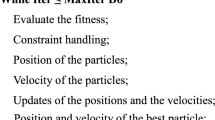Abstract
Modelling and optimization of machining process is essential in order to avoid the laborious experiments and associated expenditure. The sparse data of the machining process is often used to model the mechanical activity and further the same are used to optimize the process. Components are machined to achieve better dimensional accuracy and surface roughness. Several systems are in existence to predict the dimensional accuracy of the components, whereas surface roughness estimation systems are rare. To achieve desired surface roughness operators needs experience in setting operating parameters such as speed (s), feed (f) and depth of cut (d). In this work, a combine flower pollination algorithm based forward mapping (prediction model) and operator friendly reverse mapping (optimization) models are developed. In prediction model, given the operation parameters it could predict the surface roughness and in optimization model, the operator will input desired surface roughness to achieve the optimized the operating parameters. As such operator friendly reduces the costly trial and error experiments, time, raises the productivity and level of automation in machining industry. The model development and optimization are carried out in Matlab® and the results are demonstrated.
Similar content being viewed by others
References
Deshpande YV, Andhare AB, Padole PM (2019) Application of ANN to estimate surface roughness using cutting parameters, force, sound and vibration in turning of Inconel 718. SN Appl Sci 1(1):1–9
Laouissi A, Yallese MA, Belbah A, Belhadi S, Haddad A (2019) Investigation, modeling, and optimization of cutting parameters in turning of gray cast iron using coated and uncoated silicon nitride ceramic tools. Based on ANN, RSM, and GA optimization. Int J Adv Manuf Technol 101:523–548
Hazir E, Ozcan T (2019) Response surface methodology integrated with desirability function and genetic algorithm approach for the optimization of CNC machining parameters. Arab J Sci Eng 44(2019):2795–2809
Saidi R, Fathallah BB, Mabrouki T, Belhadi S, Yallese MA (2019) Modeling and optimization of the turning parameters of cobalt alloy (Stellite 6) based on RSM and desirability function. Int J Adv Manuf Technol 100:2945–2968
Misaka T, Herwan J, Ryabov O, Kano S, Sawada H, Kasashima N, Furukawa Y (2020) Prediction of surface roughness in CNC turning by model-assisted response surface method. Precis Eng 62:196–203
Öztürk S, Kahraman MF (2019) Modeling and optimization of machining parameters during grinding of flat glass using response surface methodology and probabilistic uncertainty analysis based on Monte Carlo simulation. Measurement 145:274–291
Tonday HR, Tigga AM (2019) An empirical evaluation and optimization of performance parameters of wire electrical discharge machining in cutting of Inconel 718. Measurement 140:185–196
Daniel SAA, Pugazhenthi R, Kumar R, Vijayananth S (2019) Multi objective prediction and optimization of control parameters in the milling of aluminium hybrid metal matrix composites using ANN and Taguchi-grey relational analysis. Def Technol 15:545–556
Ghosh G, Mandal P, Mondal SC (2019) Modeling and optimization of surface roughness in keyway milling using ANN, genetic algorithm, and particle swarm optimization. Int J Adv Des Manuf Technol 100:1223–1242
Mohamad A, Zain AM, Mohd Yusof N, Najarian F, Alwee R, Abdull Hamed HN (2019) Modeling and optimization of machining parameters using regression and cuckoo search in deep hole drilling process. Appl Mech Mater 892(2019):177–184
Mandal N, Doloi B, Mondal B (2013) Predictive modeling of surface roughness in high speed machining of AISI 4340 steel using yttria stabilized zirconia toughened alumina turning insert. Int J Refract Met Hard Mater 38:40–46
Huang Y, Liang SY (2003) Cutting forces modeling considering the effect of tool thermal property application to CBN hard turning. Int J Mach Tools Manuf 43:307–315
Ramesh R, Ravi Kumar KS, Anil G (2009) Automated intelligent manufacturing system for surface finish control in CNC milling using support vector machines. Int J AdvManuf Technol 42:1103–1117
Yang XS, Karamanoglu M, Hi XS (2014) Flower pollination algorithm: A novel approach for multiobjective optimization. Eng Optim 46:1222–1237
Senthilnath J, Kulkarni S, Suresh S, Yang XS, Benediktsson JA (2019) FPA clust: evaluation of the flower pollination algorithm for data clustering. Evol Intell. https://doi.org/10.1007/s12065-019-00254-1
Yang XS (2014) Swarm intelligence based algorithms: a critical analysis. EvolIntell 7:17–28
Sekhar BVDS, Venkataramana S, Chakravarthy VVSSS, Chowdary PSR, Varma GPS (2019) Image denoising using wavelet transform based flower pollination algorithm. In: Mandal JK, Satapathy SC, Kumar Sanyal M, Sarkar PP, Mukhopadhyay A (eds) Information systems design and intelligent applications. Springer, Singapore, pp 391–400
Paladuga CSR, Vedula CVSSS, Anguera Pros J, Mishra RK, Andújar Linares A (2018) Performance of beamwidth constrained linear array synthesis techniques using novel evolutionary computing tools. ACES J 33(3):273–278
Author information
Authors and Affiliations
Corresponding author
Additional information
Publisher's note
Springer Nature remains neutral with regard to jurisdictional claims in published maps and institutional affiliations.
Rights and permissions
About this article
Cite this article
Umamaheswara Raju, R.S., Chakravarthy, V.V.S.S.S. & Chowdary, P.S.R. Flower pollination algorithm based reverse mapping methodology to ascertain operating parameters for desired surface roughness. Evol. Intel. 14, 1145–1150 (2021). https://doi.org/10.1007/s12065-021-00574-1
Received:
Revised:
Accepted:
Published:
Issue Date:
DOI: https://doi.org/10.1007/s12065-021-00574-1




